 Your new post is loading...
 Your new post is loading...
Nearly half of millennials (43 percent) have been misled by medical information on the internet. A recent Harris Poll found that people tend to click the first article that comes up in a search, even though such articles are often advertising content aimed at selling medicine or medical devices. When people aren't searching, they are often coming across such misleading content via social media. Of the 20 most-shared articles about cancer on Facebook last year, over half, according to The Independent, contained claims discredited by doctors and health authorities. How does this misinformation make its way into widely circulated articles? Often, it is there on purpose: Content marketing -- corporate advertising disguised as articles, videos and information -- is being systematically manufactured on an industrial scale....
Quaker State and digital media company, Onion, Inc. are continuing their partnership and launching a new video series. The brand first started working with The Onion in 2016 with the launch of six satirical videos poking fun at marketing fads such as commercial jingles and VR technology. The new series of videos focus on two pseudo Quaker State marketing interns trying to come up with the next big idea for the brand. It was developed by Onion Inc.’s creative services division, Onion Labs. “The Interns” will roll out beginning today featuring hidden camera-style footage, says Nancy Salazar, Quaker State brand manager. The series’ eight installments and accompanying social content will run throughout the rest of 2017. ...
John Oliver may have called it "repurposed bovine waste," but it appears as though native advertising isn't going away anytime soon. In fact, a new eMarketer study says that native digital display ad spending in the U.S. will grow 36.2% this year to reach $22.09 billion.
And why not? As marketing opportunities continue to splinter across a myriad of platforms and channels, at the same time as traditional interruptive ad intervals are ever avoided like a consumerist plague, brands need to find a way to get their messages across in ways we might actually want to see it. Back in 2014, The New York Times' executive vice president of advertising Meredith Levien said readers were spending roughly the same amount of time on advertiser-sponsored posts as on news stories, and the company sold upwards of $18 million worth of native ads that year. It's T Brand Studio continues to roll out some of the best examples of the ad genre, most notably still is the 2014 interactive piece "Women Inmates," a detailed look at incarceration of women sponsored by...you guessed it... Netflix for Orange is the New Black....
The nonprofit Online Trust Alliance (OTA) on Wednesday conducted a study that found 71% of native ads on top media sites fail to offer adequate labeling, transparency, and complete consumer disclosure.
This is a blow to the native ad/branded content business and should be a wake-up call for publishers and content studios.
The study, an analysis of native ads on the top 100 news websites, found that 71% earned failing scores for disclosures, delineation, and discoverability. The bottom line: The sites didn’t offer consumers the ability to easily discern pure editorial from ads.
As most readers of this column know, native advertising refers to Web site content that’s funded and produced outside the publisher’s editorial review or influence, yet is designed to appear similar to editorial on that site. As the OTA mentions, “this illustrates the tension -- paid for and controlled separately, but presented in a way to appear as editorial. The potential for audience confusion or misinterpretation is obvious, and the rapid rise in the deployment of native has already prompted concerns from advocates, media and regulators.”...
“While the industry looks at native advertising as the holy grail to drive new revenues, they are failing to address the long-term issue. With 71% of native ads failing to pass the consumer transparency acid test, this report should be a wake-up call to the industry. Inaction is not an option. Conversely, providing these concrete examples and recommendations helps advertisers, networks and publishers in moving forward,” Craig Spiezle, executive director at the Online Trust Alliance, told Native Insider via email.
Upworthy said that according to NewsWhip — which measures how content from a variety of media sites performs on social networks such as Twitter and Facebook — the site’s sponsored content performed 38 times better than the industry standard for social interactions involving content at the top 25 social publishers.
How do readers feel about all of this? Most research suggests that audiences prefer sponsored posts to banner ads, but they also appreciate it less than regular content. If you’ve come across sponsored content before, you’ll probably understand how it can be both confusing and frustrating.
In 2015, as brands continue to pour dollars into these projects, publishers will keep growing their resources and improving their output. Consequently, audiences will begin to realize that content underwritten by brands can be meaningful too.
Let’s look at some publishers that are currently leading the pack in terms of content quality, formatting and design, and reader experience:...
Ten months ago, Dell debuted as The New York Times' first paid post partner.
Dell’s paid post went live in January to neutral reviews. We called it “solid, if unspectacular… the type of boilerplate story about the changing millennial workforce that nearly every brand seems to write.”
But now, the brand is back for a second go-round with a visually impressive exploration of enterprise cloud computing. Both Dell’s first posts and the new offering were written by journalists hired by The New York Times, but this one is enhanced with proprietary research on corporate security and interactive global market data....
...But while brand storytelling may be dominating the trade conference stages, it’s not enough on its own for brands aiming to add meaningful value to their customers over the long term.
Strategies for Retention: Own Every Consumer Touch Point
Most content marketers know this particular statistic: 70 percent of consumers prefer getting to know a company via content over ads. To deliver this type of lasting, comprehensive value to their audiences, brands must build their content strategy around three core areas of focus: Foundational content Engagement content Social content...
Can Google Glass help cross cultural boundaries and even save lives? It can in "Captions," a 4-minute short film promoting a translation app currently in development.
Writer, director and editor Joe Sill of digital studio Everdream Pictures describes the cinematic clip as a "branded content spec ad," much like the team's earlier, unofficial Tesla spot, "Modern Spaceship," whose admirers included even Tesla CEO Elon Musk.
And sure enough, the new video has also gotten some top-level corporate love, with the official Google Glass page giving it a share on Facebook.
Sam Morrill, senior curator at Vimeo, also left a comment on the clip: "Interesting film. Really sharp look."
"Captions" focuses on a Glass translation app that helps a photographer in the Mexican desert communicate with a boy who's been bitten by a snake....
Those 11 inspiring videos are all original feel-good New York Times productions, and as Digiday’s Lucia Moses noted this morning, the ad is intended to drive subscription signups forThe Times, with a prominent call to action at the top of the piece imploring readers to “Get with The Times.
”While this may seem bizarre and a little too meta for this early in the morning, it’s actually a shrewd move by The Times to grow their audience. Clearly, they’ve identified Mashable readers as potential Times readers and subscribers, and as a result, they’ve come to them with a month-long campaign of branded posts._
The Times also punched up the titles of the individual videos for a Mashable audience. “Tattoo Artist Gives Breast Cancer Survivors Nipples and Hope” was originally titled “The Nipple Artist,” and “Can Your Grandma Pump Iron Like This?” was called “Shirley and the Bodybuilder.”...
At a time when good-paying freelance assignments are harder to come by, many journalists are heeding the call of native advertising, where the pay is decent and the work is steady. But there’s a cost. Many worry about the impact on their credibility as a journalist. Some are even finding they aren’t so welcome back in newsrooms once they work for the business side.
In the latest in Digiday’s “Confessions” series, we talked to a veteran freelance writer who has written for top women’s magazines and other national publications about the dark side of native. In this case, the journalist was working for a publisher’s content studio, which assigned stories a given client wanted written....
...I don’t know if the guy owned stock in Second Life, or was shacking up with the founder’s daughter, or if his Second Life avatar owned the biggest fake ad agency in that big fake world and he planned to corner the Second Life fake ad market.
All I know is that he made it clear. Laid it bare. If we weren’t building campaigns to include a serious presence on Second Life, we were doomed. DOOMED!And so today, whenever I hear someone declare that the future of digital advertising is native ads, all I hear is Second Life. And all I smell is poo....
Online advertising has grown exponentially since its foundation in the 90s. Now, online ad sales make up the majority of the industry, and savvy companies are directing the lion’s share of their budgets at the digital space.
Advertising through social media is nothing new, but so far, brands have been playing it safe, using many of the same methods that have already been successful in the past – combining banner- and text-link-style ads in news feeds and sidebars. But the possibilities of social advertising have yet to be fully explored.
The real power comes not from the reach of a company’s network, but from getting that company’s customers to do the outreach FOR them.
Social media is changing the way people view and interact with content online. While the idea of a website “page” has been a vital component in the way people understand the web, the use of feed-based content in Facebook, Twitter and Instagram has changed the concept of what a website IS. ....
|
I wrote a juicy ebook titled Master the Five Pillars of Power Publishing for the startup PowerPost and really want to share it with you. The publication actually cites two authors because the many ideas presented in it come from the sharp mind of Paul Shirer, the co-founder and CTO at PowerPost. Paul agreed to an interview with me to help shed light on how brands must address the new demands of publishing online at scale. Here’s that interview, followed by an edited transcript if you’re rather read....
In September of 2013, the late David Carr, skeptical of the burgeoning native advertising tactic that was back then “all the rage,” wrote a column titled “Storytelling Ads May Be Journalism’s New Peril.” Three months later, the Times jumped into the fray. Today the company boasts a fully-fledged content marketing arm, T Brand Studio. Adam Aston, vice president and executive editorial director of the Studio, said when it was first launched, there was a sense of anxiety among the Times’ newsroom, as well as advertisers, that the content they created wouldn’t be up to par with its editorial content. “We were really mindful from inception to approach it as fact-first, narrative-first, with a strong story, strong characters,” he said at a recent panel event, hosted by MediaRadar in New York City, about the future of native advertising. “From inception, whether we were making the simplest stories we could three or four years ago, to today, where a lot of what we’re making is a three-ring circus of interactivity, like VR and AR, we’re still driven by the same thought that the story, the quality of the reporting, finding authentic people, much in the way that our newsroom inspires readers – we want to do the same thing.” Here are five tips from the panelists for using native advertising....
"Native" advertising is expected to drive 74% of all US display ad revenue by 2021, up from a 56% share in 2016, but Reddit cofounder Alexis Ohanian isn't a fan. Native advertising is paid content that fits a specific publication's style and editorial guidelines. The idea is that unlike standard banner ads — which users can become blind to and easily overlook — people are more likely to engage with content that looks like the rest of the content on a site. Speaking at a small press conference at Web Summit in Lisbon, Portugal last week, Ohanian described native advertising as something "nobody actually reads but everyone has just bought into." Marketers have been fooled into thinking people are reading their native ads, when instead, Ohanian believes they've simply been tricked by "Facebook arbitrage."...
Therefore, content creators and advertisers may find themselves scratching their heads about how to break through the clutter with compelling branded content that attracts an audience and makes them want more. “While there’s no ‘one size fits all’ when it comes to creating impactful branded content, we’ve identified some common themes in our research and content testing that can be used as best practices for making content resonate with audiences,” said Harry Brisson, Director of Lab Research at Nielsen. To better understand how consumers are reacting to this new form of marketing content, Nielsen assessed consumer reactions to more than 100 pieces of branded content and found that a brand’s effectiveness (e.g., how a brand resonates with viewers) is largely affected by the format and environment the message is delivered in. The results of the analysis uncovered three key takeaways that can help brands deliver strong content that resonates with and builds audiences: - Branded content can drive higher brand recall and brand lift than pre-roll - When viewers enjoy content, they view the integrated brands more favorably - Partnering with a publisher can drive ad impact....
There’s not much rhyme or reason to pricing and the sponsored article itself may be bundled with other ad unit types from publishers.
One of the challenges we wanted to solve in the study was the pricing dilemma. Why does “ACME Publisher” charge so much more than “John Doe Publisher” and which one is a better deal?
We tracked sponsored content prices against explicit data factors (Domain Authority, Page Authority, AlexaReach, and Facebook, Twitter, and Pinterest followers) to find correlations that help provide clarity and justification for pricing. The ultimate goal of this is to empower marketers and media buyers to budget and negotiate more effectively while gaining a deeper understanding of the sponsored article landscape....
Today's fragmented media landscape and information-loaded digital world offer brands new opportunities to communicate directly with their audiences—building visibility, affinity and even search traction along the way.
However, success in the uppermost reaches of the funnel requires organizations to put the corporate agenda in the back seat, adopting instead a more journalistic approach to crafting and publishing their stories.
Enter brand journalism.
Not to be confused with content marketing, brand journalism is an upper-funnel tactic that delivers more than mere brand awareness. Telling the brand's stories in a compelling, audience-focused way can create affinity, earn media coverage, build brand credibility and (when coupled with search and social strategies) deliver long-lasting online visibility.
Native is one of the hottest topics in digital media, and advertisers and publishers are taking notice.
By creating advertisements that are in the same format as the content audiences are there to consume, marketers hope to provide a much less disruptive advertising experience. Native ads have also proven effective, drawing higher click rates than traditional banner ads, particularly on mobile devices.
New and exclusive data from BI Intelligence finds that spending on native ads will reach $7.9 billion this year and grow to $21 billion in 2018, rising from just $4.7 billion in 2013. We are the only research service that has provided a detailed breakdown of spend projections and growth rates for each of the three main native ad types — social-native, native-style display ads, and sponsored content. ...
...Spark and its sibling branded content and entertainment division LiquidThread and Genworth are launching an integrated partnership with CNN that makes Genworth the first advertiser to use CNN’s Content Development Studio, a unit under the network that works with advertisers and agencies to develop branded entertainment and sponsored programming.
Under the deal, Spark worked with the CNN production team to develop new informational brand creative -- both :15 and :60 second versions -- to convey the importance of planning for the future. "CNN was immensely collaborative and it is useful to use their voice to lend credibility to the conversation," says Levin.
At the same time, CNN is publishing a series of articles to educate Genworth's target Boomer audience about the importance of long-term care planning and best practices to prepare for their future. These articles will run on CNN's online channels as sponsored and organic content.....
It says something about our media culture that in a short time the term “native advertising” has gone from industry buzzword to pop culture punch line.
The two most memorable references come from HBO. On “Girls,” Lena Dunham’s Hannah takes—and soon leaves—a writing job in the sponsored content department at GQ. More recently on "Last Week Tonight," John Oliver delivers an entertaining riff about the profusion of “sponsored content” on news sites.
Oliver conceded that Netflix's native ad for the New York Times about female prison inmates, promoting the series "Orange Is the New Black," was “about as good as it gets.” This got us thinking about all the other noteworthy executions this year which demonstrate that sponsored content can indeed be good—nay, great—content. With that in mind, we asked some of the native advertising gurus here at HuffPost-AOL to name their picks for the most notable native or branded content campaigns of the year thus far, both from around the Web as well as in-house.
Here’s what we came up with, in alphabetical order by advertiser....
A population of 100,000 is no longer a guarantee that a city like Richmond, California can sustain a thriving daily paper. Readers have drifted from the tactile pleasures of print to the digital gratification of their smartphone screens, and advertising revenues have drifted with them. Titles that once served up debates from City Hall, news of school teams’ triumphs and classified ads for outgrown bikes have stopped the presses for good.
Last January, however, a site called the Richmond Standard launched, promising “a community-driven daily news source dedicated to shining a light on the positive things that are going on in the community”, and giving everyone from athletes to entrepreneurs the recognition they deserve. Since then, it has recorded the “quick-thinking teen” commended by California’s governor for saving a woman from overdosing; the “incredible strength” of the 5ft 6in high-school freshman who can bench-press “a whopping 295lbs”; and councilman Tom Butt’s warning about the costs of vacating a blighted public housing project.
The Richmond Standard is one of the more polished sites to emerge in the age of hyper-local digital news brands such as Patch and DNAinfo.com. That may be because it is run and funded by Chevron, the $240bn oil group which owns the Richmond refinery that in August 2012 caught fire, spewing plumes of black smoke over the city and sending more than 15,000 residents to hospital for medical help....
Eagle-eyed readers may notice a new feature here on Re/code today. It’s called “Sponsor Content,” and is, for us, a new form of advertising. Known broadly as “native advertising,” this is a category of ad that takes the form of an article written by, or commissioned by, an advertiser. It’s widely used online, but the technique actually goes back well before the Web, when print publications ran articles written by advertisers that were called “advertorials.”
Some websites might try to present these ads as if they were normal posts written by their reporters, editors, or curated guest contributors. We won’t be doing that. You’ll notice that we clearly label them “Sponsor Content” with a blue label instead of our usual black one. We also use the company logo next to the writer’s byline, and, at the bottom of each such post, include a disclosure statement saying that the article is a form of advertising, and was neither written by, nor edited by, our journalists.
That doesn’t mean these pieces are bad, or unworthy of your time. It doesn’t mean we are embarrassed to post them. In fact, we hope you will find them interesting. It just means we want to keep faith with you by making things clear.
It seems like everyone has something controversial to say about sponsored content these days, from John Oliver on HBO to even us here at Contently.Much of that controversy centers around two key questions: Is brand-backed content on publisher sites labeled well enough? And is it eroding the publishers’ editorial independence and reputation?
Now, a Google engineer has taken on this transparency and labeling challenge with a browser plug-in for Chrome and Firefox called AdDetector, that adds another layer of labeling to sponsored posts. It’s drumming up a fair amount of buzz in the media world already....
|



 Your new post is loading...
Your new post is loading...



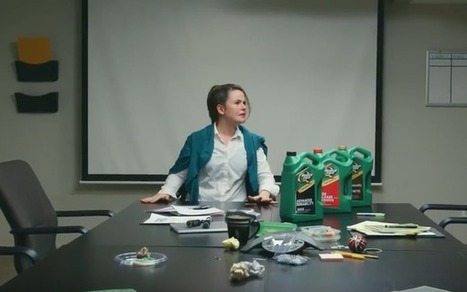
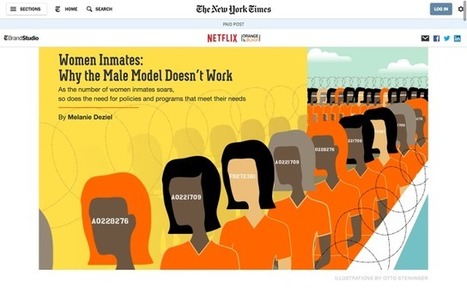
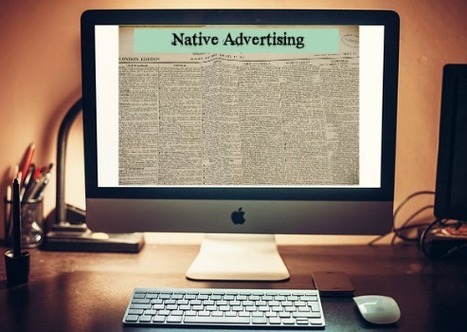


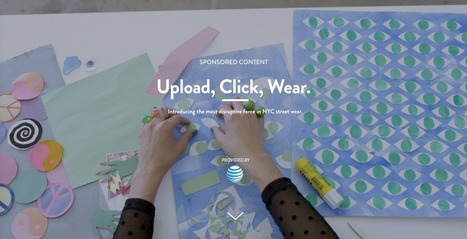


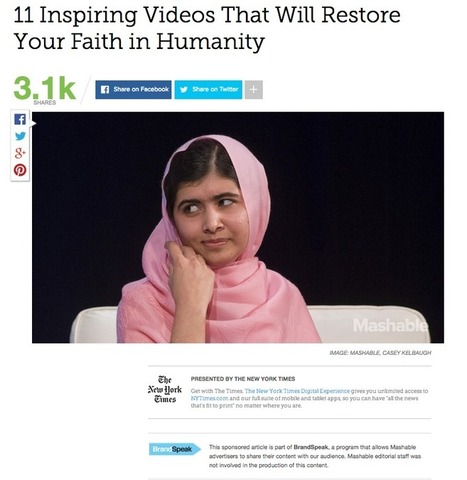

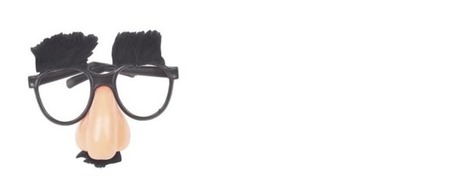


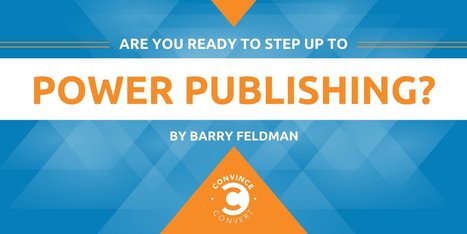
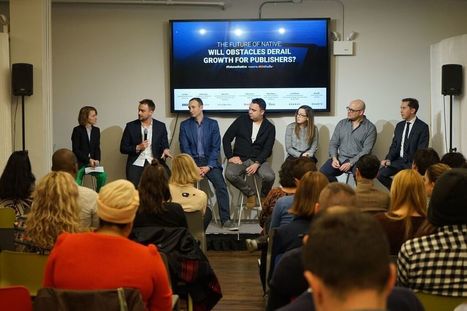


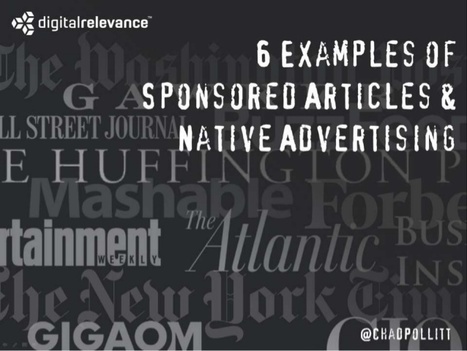


















Spin is spin, even when it is written by journalists. Tamara Pearson takes a look at fake content marketing.